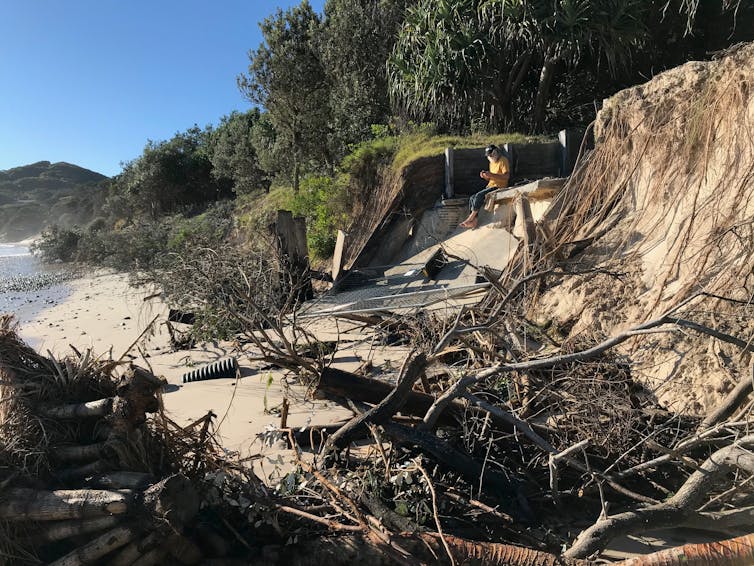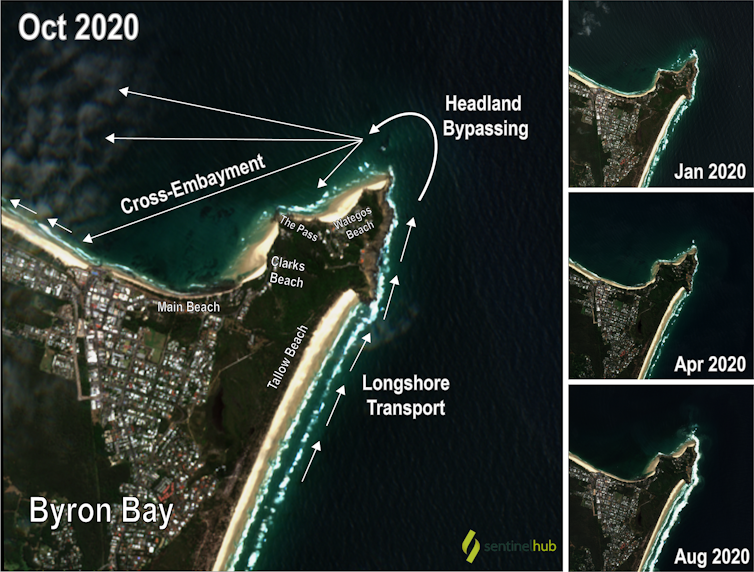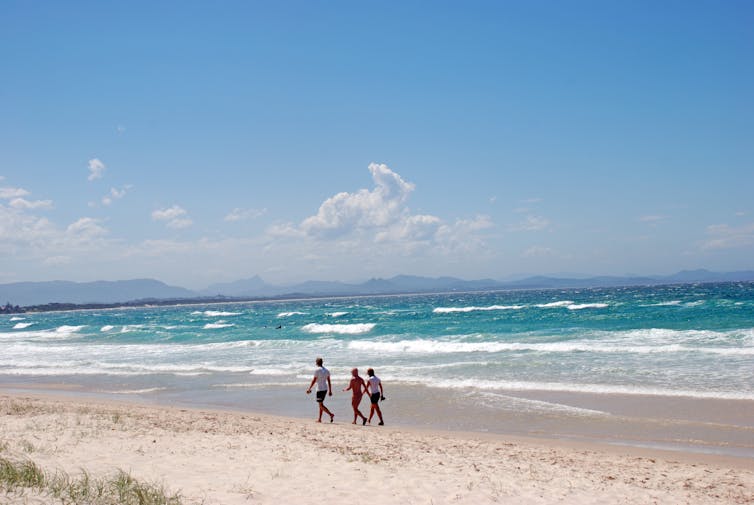One of Australia's most famous beaches is disappearing, and storms aren't to blame. So what's the problem?
- Written by Thomas Murray, Research Fellow (Coastal Management), Griffith University
Storms or tropical cyclones usually get the blame when Australia’s beaches suffer severe erosion. But on the New South Wales north coast at Byron Bay, another force is at play.
Over the past six months, tourists and locals have been shocked to see Byron’s famous Main Beach literally disappearing, inundated with water and debris. In October, lifesavers were forced to temporarily close the beach because they couldn’t get rescue equipment onto the sand. Resident Neil Holland, who has lived in the area for 47 years, told the ABC:
It’s the first time I’ve seen it this bad in all the time that I’ve been here, and it hasn’t stopped yet. The sand is just being taken away by the metre.
So what’s happening? To find the answer, we combined a brief analysis of satellite imagery with previous knowledge about the process behind the erosion and how it has been occurring at Byron Bay. The erosion is due to a process known as “headland bypassing”, and it is quite different to erosion from storms.
What is headland bypassing?
Headland bypassing occurs when sand moves from one beach to another around a solid obstruction, such as a rocky headland or cape. This process is mainly driven by wave energy. Along the coast of southeast Australia, waves generate currents that move sand mostly northward along the northern NSW coastline, and on towards Queensland.
However, sand does not flow evenly or smoothly along the coast: when sand arrives at a beach just before a rocky headland, it builds up against the rocks and the beach grows wider. When there is too much sand for the headland to hold, or there’s a change in wave conditions, some sand will be pushed around the headland – bypassing it – before continuing its journey up the coast.
Read more: King tides and rising seas are predictable, and we're not doing enough about it
This large lump of moving sand is called a “sand pulse” or “sand slug”. The sand pulse needs the right wave conditions to move towards the shore. Without these conditions, the beach in front of the pulse is deprived of sand and the waves and currents near the shore erode the beach.
Headland bypassing was first described in the 1940s. However, only about 20 years ago was it recognised as an important part of the process controlling sand moving along the coast. Since then, with better technology and more data, researchers have studied the process in more detail, and helped to shed light on how headland bypassing might affect long-term coastal planning.
Recent studies have shown wave direction is particularly important to headland bypassing. Importantly, weather patterns that produce waves are affected by climate drivers including the El Niño Southern Oscillation and the Interdecadal Pacific Oscillation. So, future changes in the way these drivers behave will affect the waves and currents that move sand along our coast, which in turn affects headland bypassing and beach erosion.
 Byron Bay’s beaches have badly eroded in recent months.
Byron Shire Council
Byron Bay’s beaches have badly eroded in recent months.
Byron Shire Council
What’s happening at Byron Bay?
In October and November this year, a large amount of sand was present just north of Cape Byron, from Wategos Beach to The Pass Beach. As this sand pulse grew, Clarkes Beach, and then Main Beach, were starved of their usual sand supply and began to erode.
The sand pulse is visible on satellite images from around April 2020. Each month, it slowly moves westward into the bay. As the sand pulse grows, the beach ahead of the pulse gradually erodes. At present Main Beach is at the eroding stage.
Read more: La Niña will give us a wet summer. That's great weather for mozzies
Similar erosion was observed at Main Beach in the early 1990s. The beach became wider again from 1995 to 2007. From 2009 onwards, the shoreline erosion slowly began again, and became very noticeable in the past six months.
The effect of sand pulses on beach erosion is not exclusive to Byron Bay. It has been described previously in other locations, such as NSW’s Kingscliff Beach in 2011. In that case, the erosion risked damaging a nearby holiday park and bowling club.
 Satellite images showing sand movement around Cape Byron.
Author provided
Satellite images showing sand movement around Cape Byron.
Author provided
When will this end?
Mild waves from the east to northeast, which usually occur from October to April each year, will help some of the sand pulse move onto Clarkes Beach and then further along to Main Beach. This normally happens over several months to a year. But it’s hard to say exactly when the beach will be fully restored.
This uncertainty underscores the need to better forecast these processes. This would help us to predict when bypassing sand pulses will occur and to manage beach erosion.
Climate change is expected to affect wave conditions, although the exact impact on the headland bypassing process remains unclear. However, better predictions would allow the community to be informed early about expected impacts, and officials could better manage and plan for future erosion.
Meanwhile, Byron Bay waits and watches – knowing at least that the erosion problem will eventually improve.
 The sand at Main Beach at Byron Bay, pictured here under good conditions, will eventually return.
AAP
The sand at Main Beach at Byron Bay, pictured here under good conditions, will eventually return.
AAP
Authors: Thomas Murray, Research Fellow (Coastal Management), Griffith University





